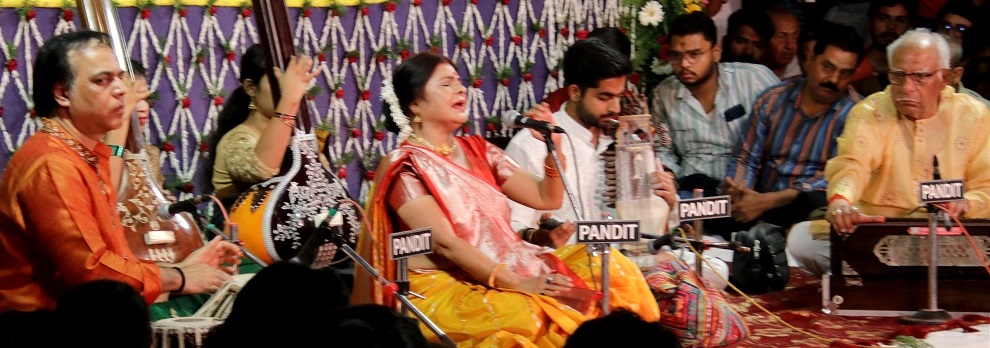Sankat Mochan Hanuman temple in Banaras recently celebrated its 101st annual music and dance festival featuring over 45 artists from diverse musical backgrounds.
Indian classical music and dance have deep roots in temple traditions, where they were originally performed as offerings to the deities. Upholding this heritage, the Sankat Mochan Hanuman temple in Banaras hosted the 101st edition of its annual music festival. This celebration, held every year on Lord Hanuman’s birthday according to the lunar calendar, takes place in the searing April or May heat, outdoors, without any air conditioning.
Over the decades, the festival has undergone significant transformations. Initially, Hanuman Jayanti was marked with just two concerts in a single day. Gradually, the event expanded to a two-day, then a three-day celebration. Today, it has evolved into a grand six-night event featuring 45 to 50 main artists, with seven to eight performances each night, totaling 45 artists this year.
First female performance accidental
Sankat Mochan festival has embraced modernity and evolved with the changing times over the decades. Initially, only male artists performed, as it was considered unseemly for women to participate due to Lord Hanuman being a bachelor. This tradition changed in 1976 by accident when Kankana Bannerji, playing the tambura behind her Guru, inadvertently lent her voice to his performance. The organizers took this as a sign from Lord Hanuman, and women were subsequently invited to perform.
In its early years, the festival featured only musical performances. In 1979, Kathak dancer Durga Lal was invited to perform, and in 1986, Odissi exponent Sanjukta Panigrahi became the first female dancer to take the stage. Since then, many renowned artists, including Birju Maharaj, Kelucharan Mohapatra, Sonal Mansingh, and Chitra Visweswaran, have performed.
Another significant change occurred when the first Muslim artist was invited. Ustad Bismillah Khan had previously performed outside the main temple, but in 2006, his nephew Mumtaz Hussain was invited to perform at the festival. Since then, many esteemed artists like Ustad Amjad Ali Khan, Ustad Nishat Khan, the late Ustad Rashid Khan, Ustad Shahid Parvez, and Ghulam Ali from Pakistan have graced the stage.

Carnatic artists were first invited in 2008, overcoming the logistical challenges of travel from distant cities like Chennai and Bangalore. Notable performers have included Dr. L. Subramaniam, the late saxophone maestro Kadri Gopalnath, violinist A. Kanyakumari, and Bombay Jayashri.
Prominent artists from diverse range
This year’s edition featured several legends, such as Hari Prasad Chaurasia, L. Subramaniam, Sajan Mishra with his son Swaransh, Kavita Krishnamurthy, Anup Jalota, Vishwamohan Bhatt, Sivamani, U. Rajesh, and Malini Awasthi. Local artists from Banaras included tabla soloist Avantika Maharaj, sitarist Birendra Nath Mishra, and vocalist Dr. K. Shashi Kumar. The Benares gharana was represented by Ritish and Rajnish Mishra, Prabhakar and Diwakar Kashyap, and Rishi and Varun Mishra.
This year, there were only two sarod players, Tejendra Narayan Mazumdar and Sur Ranjan Mukherjee, both from the Maihar gharana. The sitar players were all from Mumbai: Nayan Ghosh, Niladri Kumar, and Purbayan Chatterjee. Santoor players Satish Vyas and Abhay Rustom Sopori represented different santoor styles. Flautists included Rakesh Chaurasia and the young S Akash from Mumbai. Typically, there are percussion jugalbandis, but this year featured only one mridangam solo by Dr. Yella Venkateshwara Rao.
Memorable concerts included performances by vocalists Ulhas Kashalkar, Jayateerth Mevundi, and first-timer Shounaq Abhisheki from Pune. It was poignant to hear young Armaan Khan, recently bereaved by the untimely death of his father, Ustad Rashid Khan.
Evenings began around 7:30 PM and continued past dawn. Seating was mainly on the floor inside the temple courtyard, on the rooftop, and outside the temple with large TV screens. A sound engineer from Pune was brought in to ensure balanced sound throughout the varied spaces.
To combat the 40-degree Celsius heat, water was provided at various points in the temple compounds. Prasad from the temple was offered to sustain the audience throughout the night, and a tea shop outside the temple remained open, serving tea and snacks.
Unique appreciation
The traditional show of appreciation involves raising both hands in the air and shouting “Har Har Mahadev,” rather than clapping. The logistics of arranging this massive festival, featuring over 100 artists from all over India (including accompanists), are managed entirely by volunteers. Arranging tickets and hotel stays, as well as transportation from the airport and railway station, is a significant task, with a fleet of cars running day and night.

It is not possible to catch all 45 performances spread over six nights. Some locals attend only two or three nights, while out-of-town visitors may come for just a few evenings. Many older residents rest for a few hours between concerts, being prodded awake by a neighbor if something exceptional starts. It was heartening to see many young music lovers this year.
Despite the heat and discomfort of staying awake all night, the annual pilgrimage to Sankat Mochan remains an event to look forward to for both performers and audiences, as the experience is unmatched.
Photos : Anuj Aggarwal




